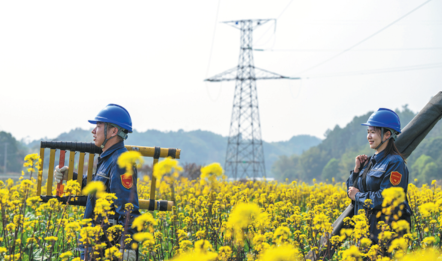Distributed renewables help power security

China's efforts to develop and utilize distributed renewable energy in rural areas will further enhance their energy security while promoting the use of clean power across the country, according to industry experts.
According to the "No 1 central document" for 2025 that outlines priorities to deepen rural reforms and solid steps to advance all-around rural vitalization, the government will further step up the development of distributed renewable energy to ensure sufficient power supply in these regions.
Distributed solar power refers to small-scale solar energy systems that generate electricity locally, typically on rooftops or land around homes, businesses or communities. Unlike traditional power plants that generate electricity centrally and transmit it over long distances, distributed solar allows users to produce their own power, which is especially beneficial for rural areas where extending the power grid can be costly.
The government will also further strengthen and enhance rural power supply security, encouraging the construction of public charging and battery-swapping facilities where conditions permit, according to the document, which was released on Sunday.
As the first policy statement put out by China's central authorities each year, the document is seen as an indicator of policy priorities.
Zhong Baoshen, chairman of Longi Green Energy Technology Co Ltd, a key player in the photovoltaic sector, said distributed solar power has become an attractive option for many rural communities, replacing expensive and inefficient traditional fuels.
Rural areas, especially those far away from the grid, often face challenges with respect to energy access. Extending the grid to these areas can be expensive and logistically challenging, he said.
"Distributed solar systems, however, can provide a decentralized solution, allowing homes to generate their own power independently of the central grid. It has the potential to revolutionize the energy landscape in China's rural regions, saving costs while boosting local economic growth."
Industry experts believe solar energy, with no fuel expenses and low maintenance costs, has been developing rapidly in China's villages over the past few years and is expected to become a game-changer in China's rural regions.
By enhancing rural power supply infrastructure, the initiative ensures stable and reliable electricity access, reducing power shortages and improving living conditions for rural communities, said Lin Boqiang, head of the China Institute for Studies in Energy Policy at Xiamen University.
"Reducing reliance on traditional fossil fuels is crucial for supporting agriculture, small businesses and local industries, driving economic growth," he said.
According to a recent guideline released by the State Council, green development will cover urban and rural areas comprehensively by 2035, with an increased reduction in carbon emissions.
Distributed photovoltaic generation has become a key driver of energy transition in China, the country's top energy authority said.
As China continues to drive its energy transition, distributed photovoltaic generation is emerging as a key contributor to the country's renewable energy efforts.
The sector generated around 346.2 billion kilowatt-hours (kWh) of electricity last year, accounting for 41 percent of the nation's total PV output, according to data released by the National Energy Administration.
zhengxin@chinadaily.com.cn






















